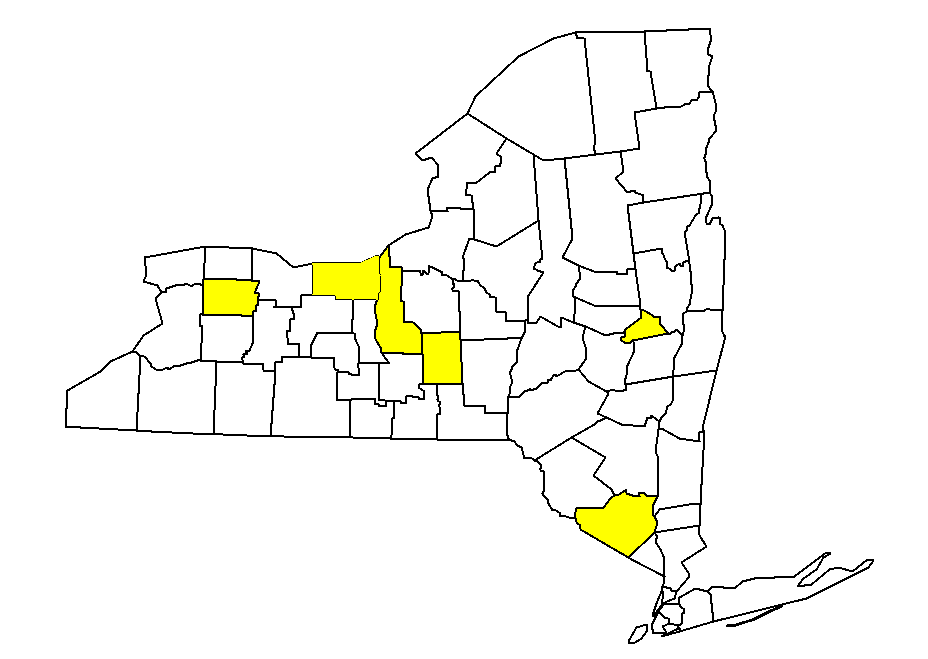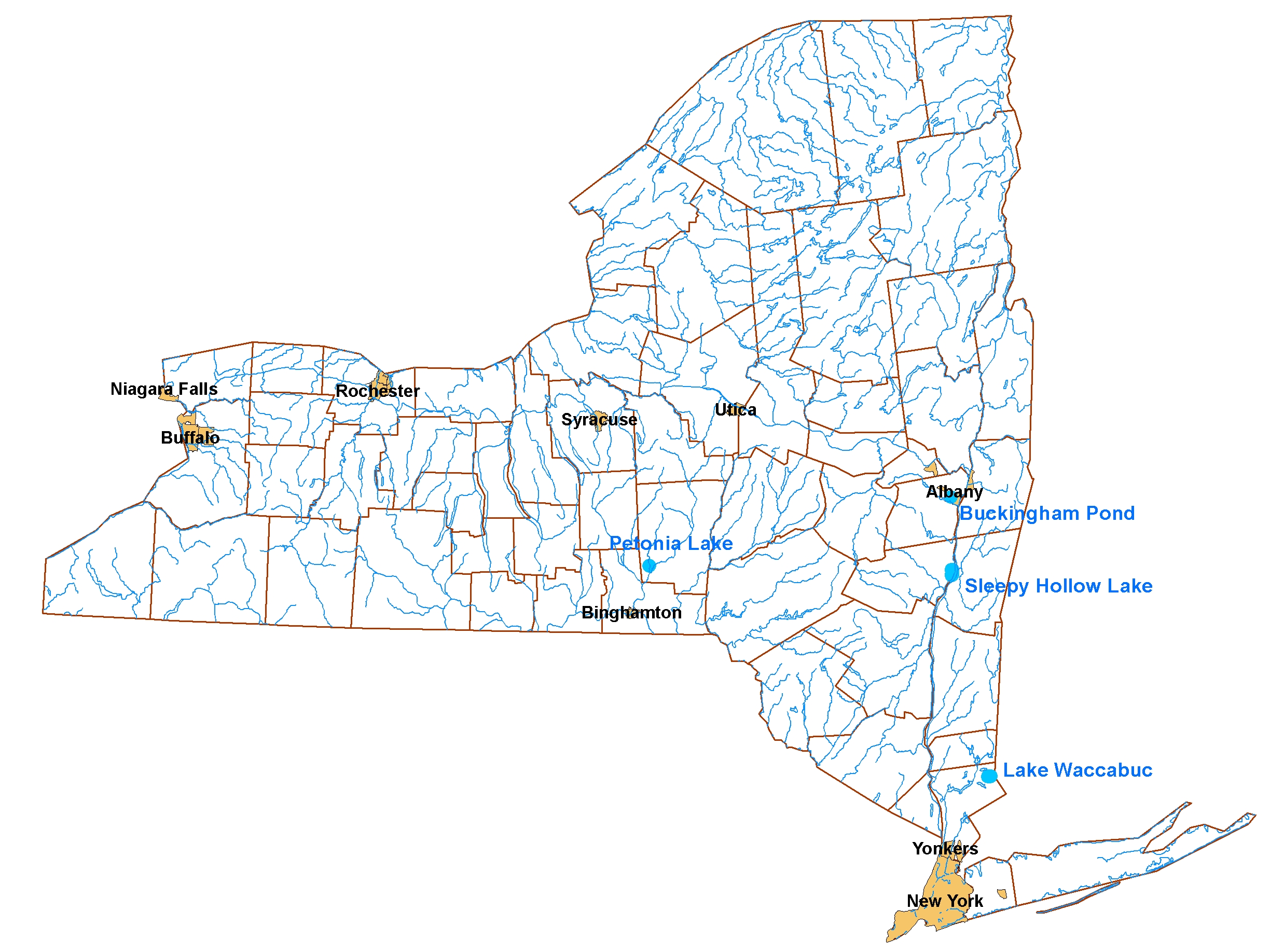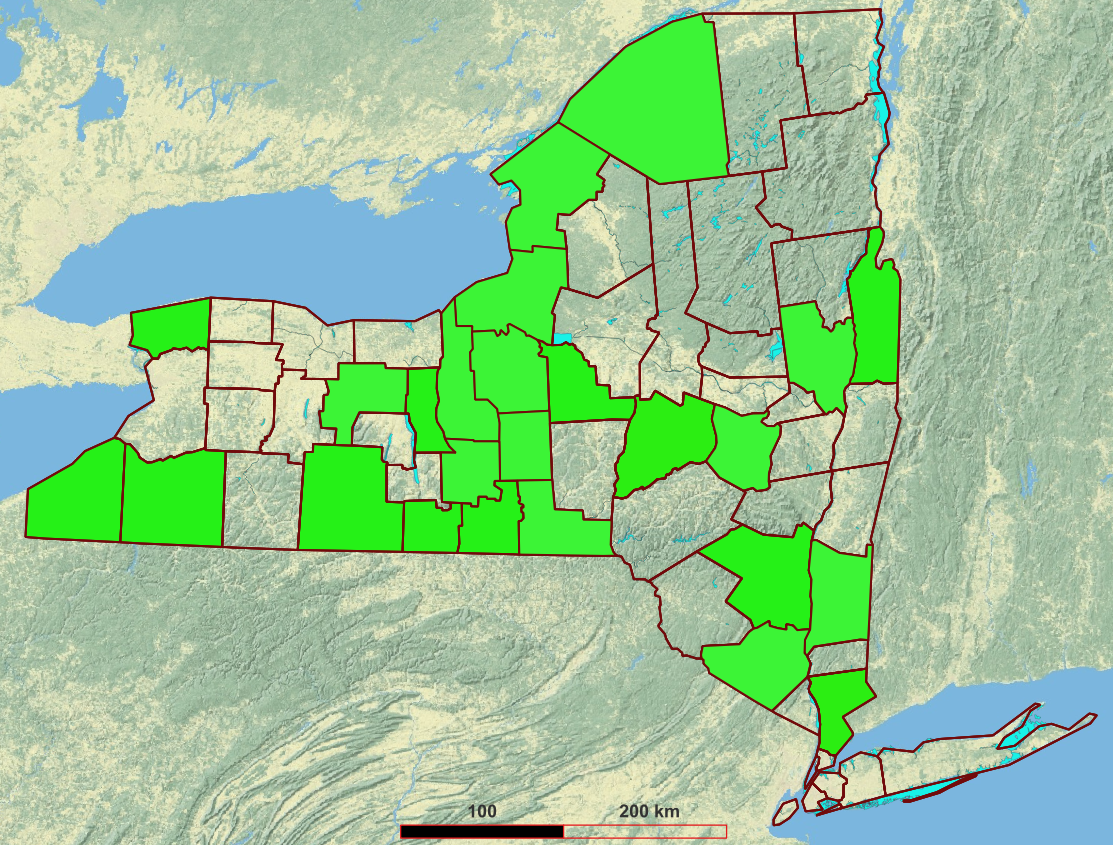graph LR; A((recruited<br>owners))-->B[Cornell<br>installs wells<br>if needed] B-->C[Cornell<br>samples<br>from wells] A-->C H((recruited lake<br>volunteers))-->E[Volunteers<br>sample<br>from lakes] C-->D[DEC and Cornell<br>analyze<br>chemistry] E-->D D-->F[Cornell<br>interprets] F-->Report Report--censored-->G((Public)) Report--censored-->I((NYSDEC)) Report--full_site<br>groundwater_data-->A Report--full_lake_data-->H
Overview Cornell+NYSDEC pesticides 2021-2025
This page introduces the 2021-2025 upstate New York pesticides in water project.
1. Purpose and context
1.1 Purpose
This set of web pages provides information to the public, and to confidential cooperators and lake volunteers, about a project sponsored by the New York State Department of Environmental Conservation, Bureau of Pest Management (NYSDEC). Cornell personnel and lake volunteers collect water samples for a NYSDEC lab to test for pesticide residues in groundwater and lakes in Upstate New York. (“Upstate” is anything north or west of New York City.) This project lasts from 2021 through 2025, and is beginning to turn out data in 2023 from 2022 vintage samples.
This work contributes to New York’s balancing act for the economic and public health benefits of pesticides, versus the potential health and environmental costs of their residues spreading beyond the immediate locations of pesticide release.
This is part of an ongoing series of joint ventures between the Cornell Soil and Water Lab and NYSDEC, and many confidential cooperators and lake volunteers, dating back to around 2000.
1.2 Voluntarism and confidentiality
The project relies on Confidential cooperators who allow Cornell to sample from wells and other environmental water access points on their properties. The privacy of the confidential cooperators is highly protected under Cornell’s contract with NYSDEC, thus nothing about the identity or specific locations of confidential cooperators will be released to NYSDEC or the public. (The cooperator can of course declare their involvement.) As a result, any release or publication of data (such as in reports, this website and or in NYSDEC’s analytical information system called EQuIS) will include only anonymized and location-blurred data.
In recent years the project has also relied on a small cadre of volunteers who carry out sampling of several lakes with Cornell’s assistance. These lake sampling volunteers are prominent locally and part of the CSLAP program thus have lesser need for anonymity, but nevertheless have the choice about release of project data to the public through this website or other media.
NYSDEC and Cornell are profoundly grateful to the confidential cooperators and lake sampling volunteers.
1.3 What New York State intends by testing groundwater and lakes
Pesticides enable food production, protection of ornamental plants, and protection of public health. They are designed to kill or greatly impair some living organisms, thus they are dangerous. A portion of pesticides amounts we use – hopefully very small – escapes from where we use them into places we don’t intend; that is the nature of the environment, particularly environmental water which gets into and out of everything, carrying much along with it.
New York has had a problem of pesticides escaping to groundwater, noticed in the 1970’s by happenings on Long Island. There can also be economic problems when beneficial pesticides are banned or withdrawn based on fear or very limited information. Keeping safe enough pesticides available is a balancing act, which scientific information can help to keep rational and effective.
Pesticide residues can reach lakes via groundwater or surface water. Thousands (?) of upstate New York shoreline households draw untreated drinking water from their lake by dipping in a pipe and sipping. NYSDEC wishes to consider their interests within the health protection aspect of its pesticide program, by doing some targeted sampling of lakes.
2. History
2.1 Long Island groundwater 1970s and onward
Long Island of New York, whose groundwater is monitored by another project with similar intentions, has had extensive well contamination by routine use of a few past pesticides (starting in mid 1970s), which led to a major shift in manufacturer and agency regulatory approach there and triggered very extensive monitoring in several US regions. Long Island’s own monitoring began to include close-up monitoring of individual pesticide users after 2000; this and other very extensive monitoring data from the Suffolk County Department of Health Services have been factored into tightened pollution prevention strategies.
2.2 Upstate groundwater
Cornell has sampled upstate private wells in six counties for NYSDEC, yielding one-time data for around 240 wells. Cornell revisited wells in several of these counties with seasonal sampling for a year or longer.
Besides private wells in several counties, we sampled a Karst (dissolving carbonate rock) area. Groundwater in Karst-related fissures is vulnerable to rapid contamination from the surface, including the entry of water via sinkholes in fields and streambeds that connect to fissures.
Our group studies how the ubiquitous herbicide glyphosate moves in the environment, with most emphasis on escapes to surface water. In 2016 we found high concentrations concurrently in runoff and in our tile drain, indicating that there are paths for ordinarily “sticky” glyphosate to reach shallow groundwater.

2.3 Lakes
An earlier NYS DEC/Cornell project sampled four lakes (Figure 2) in one round and returned to two of the lakes (Lake Waccabuc, Sleepy Hollow Lake) in a second round. The US Geological Survey (USGS) sampled lakes among its pesticide work with New York State.

3. Project domain and where it has reached
For this project’s purposes, Upstate New York means New York State land that is north or west of New York City.
The 2021-2025 project has three types of sampling sites: categorical groundwater, long term groundwater, and lake surface water. 2021 was mainly preparation for the project including building a geographic database and developing a recruitment strategy. In 2022 we recruited most categorical cooperators and lake volunteers, installed wells where needed at the categorical sites, and began sampling at categorical and lake sites. Recruitment of long term sites began in 2023 and sampling of them began alongside the next sampling of categorical and lake sites. Analytical data interpretation began with the return of pesticide results from the DEC lab in early 2023, now relayed to the categorical owners and lake volunteers.
By mid 2023, the project has recruited around 95% of its final cooperators and is getting closer to a routine cycle of sample-analyze-interpret-report.
There is companion work by Suffolk County covering Long Island.
The upstate project has reached 25 counties (Figure 3). This wide range is to search for rarer and unexpected conditions that could affect the environmental fate of pesticides. We do not expect to encounter many cases of upstate conditions as vulnerable to groundwater contamination as much of Long Island has proven to be. The sensitivity of modern lab techniques guarantees that we will definitely find some residues – especially breakdown products – of certain popular chemicals at very low levels, as we did in earlier work. 2022 results included metolachlor breakdown products at several sites, at concentrations far below levels of concern. These earliest findings confirm that many of our monitoring points and sampling techniques are working as intended.

The project proceeds as outlined in the diagram below:
4. Roadmap to this web pageset
- Categorical pesticide user sites
- Long term sites
- Lake sites
- Project outputs
- Methods for sampling, analysis, and data
- Project outputs
- Technical quality assurance material
Or graphically:
graph TD; Overview-->B[categorical<br>sites] Overview-->C[long term<br>sites] Overview-->D[lake sites] Overview-->Outputs Overview-->Methods Overview-->Q[QAPP] Methods-->E[GIS] Methods-->F[categorical site<br>characterization] Methods-->G[monitor<br>wells] Methods-->H[sampling] Methods-->I[analytical] Methods-->J[database] E-->K[Detailed technical HowTos] Q-->K F-->K G-->K H-->K I-->K J-->K
5. Credits at Cornell
Cornell Principal investigators:
- Tamme S. Steenhuis, Professor
- Brian K. Richards, Senior Research Associate
Other project staff:
- Ani Schatz
- Naaran Brindt
- Steve Pacenka (including web authoring and data quality assurance)
All are affiliates of the Cornell Soil and Water Lab.
6. Credits at NYSDEC
Bureau of Pest Management: Scott Menrath, Jeanine Broughel, Jim Carpentier, Leili Vogl.
Division of Air analytical lab: Christine Van Patten, Pete Furdyna
Last updated: 2023-11-06, sp17 AT cornell.edu

Web material composed in Markdown and Mermaid languages, with the help of static website processor Quarto.